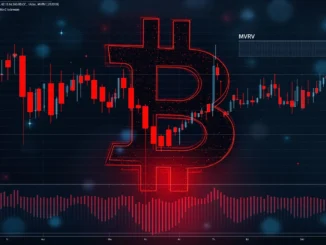
In a compelling analysis that has sent ripples through the crypto and traditional finance worlds, Arthur Hayes, the influential co-founder of BitMEX, is making headlines once again. This time, he’s not just talking about market trends; he’s laying out a strategic roadmap for investors navigating the turbulent waters of global economics. Hayes is unequivocally recommending a dual accumulation strategy: gold and Bitcoin. But why this seemingly contrasting duo? Let’s delve into Hayes’ rationale and uncover the powerful insights behind his recommendation.
Unpacking the Looming Shadow of US Debt: Why Hayes is Sounding the Alarm
Hayes’ argument is rooted in a critical observation about the escalating US debt. He took to X (formerly Twitter) to highlight a stark reality: since the gold standard’s abandonment in 1971, the outstanding U.S. Treasury debt has ballooned an astonishing 85-fold. To put this into perspective, imagine a single dollar growing into $85 – that’s the magnitude of credit expansion Hayes is pointing to.
But why is this significant? Hayes explains that this massive credit creation was, in part, necessary to fuel the growth of the global economy. The U.S. dollar, as the world’s reserve currency, played a pivotal role in this expansion. Essentially, the U.S. had to “print” dollars to meet the increasing demands of global trade and economic activity. This system, however, may be approaching a critical juncture.
The Trump Factor: A Potential Game-Changer for Global Finance?
The potential shift, according to Hayes, is intertwined with the possible return of Donald Trump to the White House. Trump’s campaign promises, particularly his focus on reducing the trade deficit, are central to Hayes’ analysis. If Trump’s policies aim to curtail the trade deficit, it could mean a significant change in the global flow of dollars.
Here’s the crux of Hayes’ argument:
- Reduced Dollar Printing? Trump’s policies might lead to a decrease in the U.S.’s willingness or need to continuously print dollars to finance trade deficits. This is a departure from the post-1971 era of credit expansion.
- Dollar Scarcity and Investor Reaction: If the dollar supply tightens, investors globally who are holding dollar-denominated assets like U.S. bonds and stocks might face a dollar shortage.
- The Great Sell-Off? Facing a dollar crunch, these investors might be compelled to sell off their U.S. bonds and stocks to secure the dwindling supply of dollars. This could trigger significant market volatility.
Beyond Tariffs: The Erosion of Trust in the Dollar System
Hayes doesn’t believe that a mere softening of Trump’s tariff policies will be enough to reassure global partners. He argues that countries already subjected to the unpredictable nature of these policies will be hesitant to maintain the same level of dollar dependency as before. The trust in the dollar-centric system, once unshakeable, may be fraying.
This is not to say the dollar will lose its reserve currency status overnight. Hayes acknowledges its continued dominance. However, he anticipates a strategic shift towards diversification, particularly towards gold, for international settlements. Nations may seek to bolster their gold reserves as a hedge against dollar volatility and geopolitical uncertainties, mirroring a return to pre-1971 trade dynamics, albeit in a modernized context.
The Hayes Investment Strategy: Gold, Gold Miners, and Bitcoin – A Trifecta for the Future?
So, how does this macroeconomic outlook translate into actionable investment strategy? Hayes provides a clear and concise prescription:
“For those who want to adapt to a return to pre-1971 trade relationships, buy gold, gold miners and $BTC,” he stated emphatically.
Let’s break down each component of this intriguing trifecta:
Gold: The Timeless Store of Value
Gold‘s appeal as a safe-haven asset is deeply rooted in history. In times of economic uncertainty, gold has consistently served as a reliable store of value. Hayes’ recommendation of gold aligns with this traditional wisdom. As concerns about US debt and dollar devaluation escalate, gold‘s intrinsic value and limited supply make it an attractive hedge against inflationary pressures and currency risks.
Gold Miners: Amplifying Gold’s Potential
Investing in gold miners adds another layer to the strategy. Gold mining companies are businesses that extract gold from the earth. Their profitability is directly linked to gold prices. When gold prices rise, gold miners typically experience amplified gains. This leverage effect can enhance portfolio returns in a bullish gold market. However, it’s also crucial to remember that this leverage works both ways; gold miners can also experience magnified losses if gold prices decline.
Bitcoin: The Modern Digital Gold
And then there’s Bitcoin. Hayes’ inclusion of Bitcoin in his recommended portfolio is particularly noteworthy. He positions Bitcoin as the “digital gold” of the 21st century. Like gold, Bitcoin possesses characteristics that appeal to investors seeking alternatives to traditional financial systems. Its decentralized nature, limited supply (capped at 21 million coins), and growing adoption make it a compelling asset in an era of digital transformation.
Here’s a quick comparison of the three assets Hayes recommends:
| Asset | Key Benefits | Considerations |
|---|---|---|
| Gold | Proven store of value, inflation hedge, safe-haven asset, tangible | Can be less liquid than other assets, storage costs, price volatility |
| Gold Miners | Leveraged exposure to gold prices, potential for higher returns in a gold bull market | Higher volatility than physical gold, company-specific risks, operational challenges |
| Bitcoin | Decentralized, limited supply, digital store of value, potential for high growth, increasing adoption | High volatility, regulatory uncertainty, relatively new asset class |
Actionable Insights: How to Navigate This Investment Landscape
Hayes’ recommendations are not just theoretical musings; they are actionable insights for investors looking to proactively position their portfolios. Here’s a summary of key takeaways and actionable steps:
- Acknowledge the Macroeconomic Shift: Recognize the potential for a paradigm shift in global finance driven by US debt concerns and evolving geopolitical dynamics.
- Diversify Beyond Traditional Assets: Consider diversifying your portfolio beyond traditional stocks and bonds to include alternative assets like gold and Bitcoin.
- Explore Gold and Gold Miners: Research and consider allocating a portion of your portfolio to physical gold and/or gold mining stocks for potential inflation hedging and leveraged returns.
- Embrace Bitcoin’s Potential: Understand Bitcoin‘s role as a digital store of value and consider its inclusion in your portfolio as a long-term investment.
- Stay Informed and Adapt: Continuously monitor macroeconomic developments, policy changes, and market trends to adapt your investment strategy as needed.
Conclusion: A Strategic Pivot Towards Resilience
Arthur Hayes’ call to accumulate gold and Bitcoin is a powerful statement about the evolving global financial landscape. It’s a call to action for investors to think beyond conventional wisdom and prepare for potential shifts in the dollar-dominated system. By understanding the underlying drivers – the escalating US debt, geopolitical uncertainties, and the potential for dollar devaluation – investors can strategically position themselves to not just weather potential storms but also capitalize on emerging opportunities. Hayes’ strategy is not just about reacting to market conditions; it’s about proactively building a resilient and future-proof portfolio in an era of unprecedented economic change. The message is clear: in a world potentially returning to pre-1971 dynamics, gold and Bitcoin are your allies in navigating the financial frontier.



